August 26, 2008 — In 2005, Jamie Hyneman and Adam Savage, special effects experts better known by the title of their popular Discovery Channel series, "MythBusters", were asked during an interview about the myth they would most like to test provided an unlimited budget.
"Jamie and I have done the research, and figured that the only way to end the debate about the 'myth' of the Apollo moon landing is to go there," Savage replied to Slashdot, a technology news website, about the belief held by some that the United States faked the lunar landings.
Three years later, the Mythbusters are ready to share the results of their 'trip' as they devote their next show, airing on Wednesday, to the moon landing hoax.
"We built a hybrid rocket that was fueled by poo and nitrous oxide — thought we had enough Teflon tape on the seals but the stink got through anyway. Too bad that the footage got lost in transit to the editors," Hyneman told collectSPACE, explaining that their limited budget would not cover the cost of regular rocket fuel.
Of course, he was joking.
"Dude, I sooo wished we could have gone there," Savage admitted.
So, with their feet firmly planted on the Earth (at least for most of the time, but more on that later), Hyneman and Savage, along with fellow Mythbusters Tory Belleci, Kari Byron and Grant Imahara, set out to use science to 'bust' or confirm the truth behind the hoaxers' claims.
Low hanging fruit
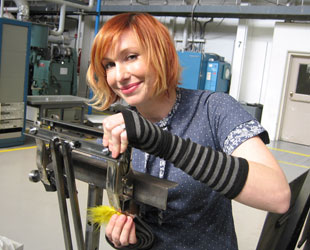
Kari Byron works to recreate the Apollo 15 feather and hammer test in one of NASA's vacuum chambers. (Discovery Channel) |
Hoax believers have had 40 years to devise reasons why the Apollo moon landings must have been filmed in an Earth-based studio. As special effects experts, Hyneman felt they were well suited for the subject.
First however, they needed to choose which parts of the myth to test.
"We looked at the ones that for some reason or other, seemed most prevalent," explained Savage in an e-mail to collectSPACE.
"We took the low hanging fruit," Hyneman concurred.
"The key idea was that the footage that proved we were there was a special effect. Adam and I are experienced effects artists, so it was natural for us to dig into it."
"We wanted to tackle the ones that actually take some experimentation to prove," added Savage.
To narrow the field however, the Mythbusters sought the assistance of someone very familiar with debunking the moon hoax myth, or they would have if he had not come calling first.
"I was actually first involved with the Mythbusters early on, when I was contacted by one of their producers asking if I had any astronomical myths for them to bust," shared Dr. Phil Plait, a.k.a. "The Bad Astronomer", in an interview with collectSPACE. An astronomer who worked with the Hubble Space Telescope, Plait created a website, Bad Astronomy, aimed at dispelling astronomy and science based myths, including the moon hoax, which expanded into books and his recent appointment as president of the James Randi Educational Foundation.
"I made some suggestions but sadly they didn't use any of them. I guess most of them don't make very good TV."
That early interaction, which was followed by meeting the Mythbusters at conferences, led to Plait establishing a relationship with the show. So he was surprised when a fellow astronomer contacted him about the Mythbusters investigating the moon hoax.
"I hadn't heard anything about [this show] so I fired off an e-mail to Adam Savage and said, "What gives?" and he e-mailed me back and said, "Oh oh oh, we're going to ask you about this," recalled Plait.
"Over the course of a few days, they were on the phone with me and a lot of other people who knew about, for example, the properties of the lunar surface, to try to figure out not just the best way of debunking the moon hoax but the best aspects of it... so they wanted to know which ones that they had found were the ones that I ran into and what were the best ways to tackle them. It was actually a lot of fun."
Ultimately, Hyneman, Savage and the others settled on three major areas of the hoax: how light interacted with the lunar surface, how the astronauts appeared to move in the low gravity of the Moon and how items behaved in the airless void of space.
How to fake the Moon
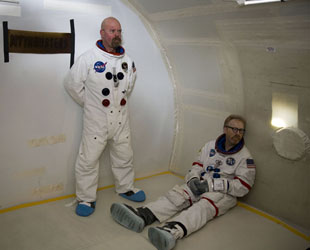
Have spacesuit, will myth-bust: Jamie Hyneman (standing) and Adam Savage on a parabolic one-sixth gravity flight. (Zero G) |
First up for Hyenman and Savage were the myths that surround the photography taken on the lunar surface. In some of the photos, shadows appear to fall in different directions while in others items in the shadow appear to be lit by a secondary light source.
To test that premise, the Mythbusters set about building a miniature Moon, as is documented in the episode.
"We really wanted to do the shadows one (the myth that somehow the sun cast unparallel shadows) full scale, with me and Jamie in spacesuits," explained Savage. "But we ran out of time and had to do it in scale. I'm still happy with the results, but we had a cool plan for a massive moon surface on the cheap. I would have liked to try it."
That's not to say that the two didn't don spacesuits for the show. For their second myth, Savage and Hyneman investigated the hoax about walking on the moon, including how the government shot the footage in a studio and then simply slowed it down for that famous "low-lunar gravity look."
To accomplish this, the two re-visited the hangar where they earlier tested if you get wetter running or walking in the rain. Savage, using his personal spacesuit costume, tried recreating the astronauts' saunter, skip and jump in Earth's gravity and with the benefit of a weight-offsetting rig, but to judge those results found they needed the real one-sixth gravity experience, which led them to the Zero Gravity Corporation.
Best known for their FAA-approved 'weightless' parabolic flights, Zero-G modified their flight plan to provide the extra time in the one-sixth gravity environment needed by the Mythbusters. For brief periods, Savage and Hyneman were under the same pull as the Apollo astronauts' lunar spacewalks.
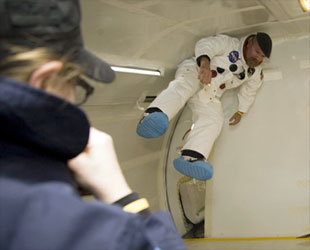
Jamie Hyneman floats aboard a Zero-G parabolic flight. (Zero G) |
"I found it very similar to scuba diving, except for the lack of the resistance to movement, which water does quite a lot," described Hyneman of the experience. "The difficult part was the transition [from low to increased gravity], which in this situation was very rapid. It happened in a few seconds, which the first few times was like a really severe roller coaster ride."
Savage found lunar gravity to be "amazing" and "so much fun."
"Also [it was] so satisfying given the other testing on that myth that we did in the episode. The Zero G flight was a fantastic capstone in our experimentation regarding moon movement."
The other three Mythbusters couldn't help but be envious of their colleagues experience.
"I was so jealous especially since there was a chance early on that we might get that story," explained Tory Belleci, part of the Mythbusters' Build Team. "I mean, talk about the world's greatest rollercoaster — and to not be able to ride it. I was extremely disappointed."
Kari Byron agreed when asked by collectSPACE if she, too, was jealous. "I would like to say 'no' because we all support one another completely. The real answer is 'Heck yeah!' Adam was giggling like a school girl. It looked like a blast."
The trio, also including Grant Imahara, were instead sent to the Marshall Space Flight Center in Alabama, where they sought the use of NASA's vacuum chambers to test how bootprints are possible without moisture and how the U.S. flag could appear to be flapping on the Moon, a task they took seriously.
"Accuracy is always a big part of our testing, so we made a special effort to get a flag made by the same company to the original specifications," said Imahara. "In addition, we obtained copies of the original plans for the Lunar Flag Assembly and re-created it exactly."
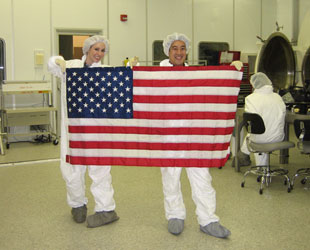
Kari Byron and Grant Imahara pose with the U.S. flag. (Discovery) |
The three were impressed by the welcome they received from NASA.
"I think the engineers were just as excited to work with us as we were with them. The thing that impressed me the most about them was how kind, humble and helpful they were. We got to work with actual rocket scientists. I love that," Imahara told collectSPACE.
"They cooked us BBQ. I am pretty sure that is southern for 'We like you.'," shared Byron.
Moon hoax busted?
To learn the results of the Mythbusters' tests, the public will need to watch the show when it airs on Wednesday, but regardless the outcome, the five cast members held no illusions that they would be able to sway the diehard moon hoax believer.
"The thing that I've found over the years is that there is always a certain segment of people out there who will refuse to believe despite overwhelming evidence. Those diehards will never be convinced, while everyone else will have fun watching us take on the hoax," said Imahara.
"In my experience, you can't convince a conspiracy theorist that the sky is blue even if he is looking up," said Byron. "I have confidence that most of our audience will be satisfied."
"I don't think the diehard believers will ever be convinced that the moon landing happened, no matter what evidence is shown," added Belleci.
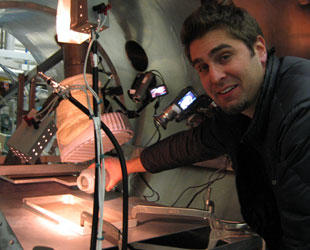
Tory Belleci tests if bootprints can exist in a vacuum. (Discovery) |
Savage and Hyneman said they found common themes between the hoax and the other myths they have tested.
"There seems to be a common tendency among conspiracy theorists, as well as among a lot of people with entrenched belief systems, to get stuck on an idea and never give up. Conspiracy theories are not really a special category — maybe you can call them myths, but I look at them as an obsession that people want to maintain, like being abducted by aliens, Bigfoot and so on. You can't really expect that reasonable evidence will change anyone's mind if they are determined," said Hyneman.
"The moon hoax shares its roots with every other conspiracy theory: the strangely comforting idea that someone is REALLY in charge, for good or ill. The idea of an overarching intelligence that moves things and public opinion with perfect precision is the subject of countless books and movies, but in reality it's far from true. We WANT it to be true, but good and evil are usually far more banal," explained Savage. "Do we really think that the same government that screwed up so badly during the Watergate scandal could have perpetrated the moon hoax? Come on!"
So if they won't sway the diehard moon hoax believers, why test the myth?
"Assuming that they show that, 'Oh look, here is why the shadows aren't parallel [or] oh look, here's why you can see details in the shadows and here's why a flag can be flapping even in a vacuum,' and that sort of thing, assuming that they show that these things can really happen they will be showing millions of people — because their show is so popular — that these moon hoax claims are garbage," said Plait.
Mythbusters 'NASA Moon Landing Hoax' episode debuts August 27 at 9:00 p.m. ET/PT on the Discovery Channel.
